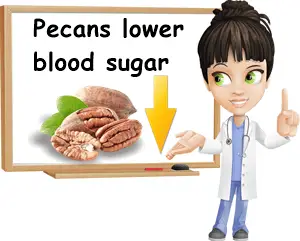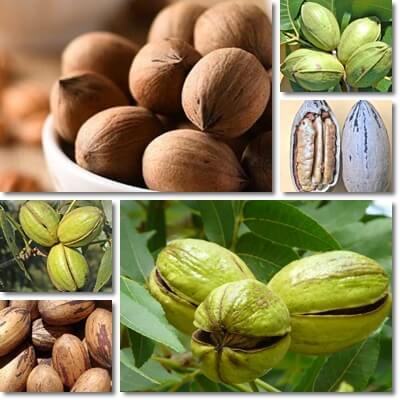Pecans are one of the best types of nuts a diabetic can eat with their condition. They have a low GI score and minimal glycemic effects so they don’t raise blood sugar levels. Actually, eating pecans with other foods that are higher in carbs lowers the effects on blood sugar of those other foods as well. Of course, because of their significant energetic value and extreme fat content (over 70 g of fat per 100 g), pecans are best consumed in moderation, as part of a varied, balanced diet, to avoid weight gain.
Pecans glycemic index is low, presumed to be in the 20’s range, similar to that of most other nuts and seeds. What this means is they have a minimal impact on blood sugar both in diabetics and non-diabetics. The glycemic index (GI) measures how fast the carbohydrates in a food raise blood sugar. Below 55 is a low GI. Between 56-69 is a moderate GI. Between 70-100 is a high GI. If you have diabetes, it’s advisable to eat low GI foods as often as possible and avoid high GI foods to the best of your efforts.

How it works: Digestible carbohydrates in food raise blood sugar because they are broken down into actual sugar during digestion which is then absorbed into the bloodstream, raising blood levels. But some foods such as pecans and other nuts and seeds in general are low in carbohydrates (13.86 g of carbs per 100 g of pecans). Even more, most of the carbohydrates in pecans are actually dietary fiber, 9.6 g per 100 g to be exact. Dietary fiber is essentially indigestible plant material that doesn’t contribute to one’s nutritional status, but slows down stomach emptying and the rate of sugar absorption into the bloodstream. This leaves only 4.26 g of digestible carbohydrates to fuel the rise in blood sugar, a fairly small amount.
However, pecans are also an impressive source of dietary fat (71.97 g of fat per 100 g) and have a good protein content (9.17 g of protein per 100 g). Both fat and protein take a lot longer to digest than carbohydrates and delay the whole process which holds beneficial effects for blood sugar control, similar to dietary fiber. Additionally, considering the difference between the carbohydrate and fat and protein content in the nuts, the higher fat and protein amounts offset the glycemic effects of the lesser carbohydrate content, with benefits for blood sugar control.
But given their high energetic value (690 kcal per 100 g) and high-fat content, there is a limit to how many pecans or other nuts you can eat in a day. In the case of pecan nuts, one ounce or 28.35 g or the equivalent of 19 halves can be considered one serving. And this little only gets you 3.93 g of total carbs of which 2.7 g dietary fiber and just 1.23 g of digestible carbohydrates to fuel the rise in blood sugar. Which is very little really.

So do pecans raise blood sugar levels?
They are a source of digestible carbohydrates which are broken down into sugar and absorbed into the bloodstream, so technically yes, pecans do raise blood sugar. But because a serving provides very few carbohydrates overall (less than 4 g total and only 1.23 g of them are digestible carbs), the rise is rather imperceptible. And with over 20 g of fat per ounce to counteract the glycemic effects of the carbohydrates, not to mention protein and fiber, the rise in blood sugar can very well go unnoticed. You can even say pecans don’t raise blood sugar because their glycemic effects are minimal.
But do pecans lower blood sugar levels?
If considered together with other, higher-carb/higher-glycemic foods, then yes, pecans can lower blood sugar levels. That is, if you eat pecans with fruit or some root vegetables, foods that are higher in carbohydrates and have a higher GI score than them, then the pecans will help lower the glycemic effects of those other foods. This effect is owed to the same nutrition elements that are responsible for the minimal glycemic effects of the nuts: the low-carbohydrate, high-fiber, high-fat, good protein values.
If you are diabetic, it’s actually advisable to pair low GI foods with higher GI ones so that you may enjoy better blood sugar levels after eating. Of course, that doesn’t mean eating pecans with bread or walnuts with honey. It however means you can have a banana or a slice of cantaloupe, some grapes or pomegranate seeds or another fruit or even vegetable you like with some nuts and the nuts will balance out the fruits’ carbohydrate content helping you enjoy better blood sugar control.
